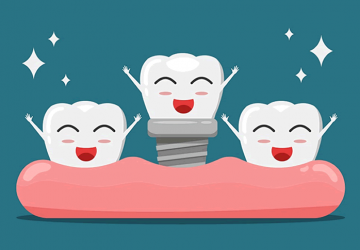- Published on
Revolutionary Breakthrough in Smile Restoration: The Wonders of Dental Implant Innovations
Revolutionary Breakthrough in Smile Restoration: The Wonders of Dental Implant Innovations
The introduction of dental implant technology has revolutionized restorative dentistry, providing an improvement over older methods of replacing teeth. Dental practitioners are dedicated to achieving the best patient outcomes, and with the adoption of dental implants as a regular treatment option, they can offer solutions that improve both the function of biting and chewing, and the aesthetic appeal of a patient's smile. This text delves into the critical impact of dental implants on improving both dental health and patient contentment.

Artificial Tooth Roots and Restorative Care
Dental implants are essentially synthetic tooth roots, typically made from titanium, that a dental surgeon embeds into the jawbone to hold a dental prosthesis. This innovative approach in restoring tooth loss is comprehensive as it not only replaces the tooth but also offers a placeholder that encourages bone growth. The particular type of titanium utilized promotes the bone to envelop the implant, a process known as osseointegration, which results in a stable foundation surpassing other forms of dental prosthetics.
Evolution and Aesthetics
The journey of dental implant development is a testament to the evolving knowledge in engineering and biology. Initially, the primary concern of implants was function; however, with advancements in the technology, focus on aesthetics has grown in significance. Contemporary implants are designed to mimic the look, feel, and function of natural teeth. They are created to fit the gum's natural contours and align with neighboring teeth, achieving a natural look.
Precision and Computer-Guided Surgery
A crucial improvement in the field is the use of digital imaging and computer-guided surgery which brings about unprecedented precision. Advanced software supports detailed surgical planning, reducing risks and guaranteeing accurate implant positioning. Dental professionals use 3D imaging to evaluate jawbone health and density, critical factors in the success of the implant.
Implants’ Benefits on Oral Health
Dental implants do more than just replace missing teeth; they help preserve the natural bone structure and encourage bone growth, preventing the bone loss typically associated with tooth loss. This function is important as it keeps the facial structure's integrity intact and sets the stage for potential future dental procedures.
Life-Changing Advantages for Patients
For patients, the benefits of dental implants are substantial. They offer a more permanent and stable solution than removable dentures, allowing patients to enjoy food, speak effectively, and socialize without concern for their teeth's stability. Moreover, unlike bridges, implants do not need modification of the surrounding healthy teeth, helping preserve the patient's natural dental makeup.
Limitations and Accessibility
Despite the high success rate, the technology has its limits, including cost, which can be a barrier for some, and the necessity for sufficient bone density that may lead some patients to require extra procedures like bone grafts. Nevertheless, advancements continue to broaden the accessibility and appropriateness of dental implants to a wider audience.
A Look into the Future
The future of this technology is bright, with research aimed at enhancing materials and techniques to better the osseointegration process and trim down recovery periods. Exciting developments, like the use of stem cells and alternate materials, are poised to improve patient outcomes further. In essence, the role of dental implant technology in restorative dentistry has been substantial, offering patients a dependable and enduring option for tooth loss. Continuous improvements in implant technology promise to provide even more efficient treatments for dental professionals moving forward. Dental implants not only refine tooth functionality but also positively influence patient's lives, showcasing the technology's vital place in contemporary dental care.